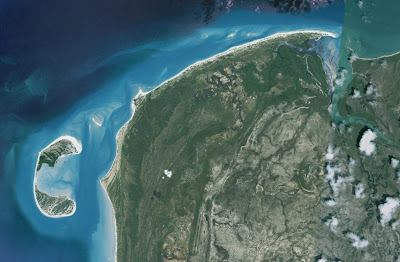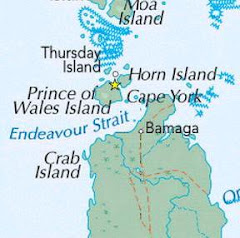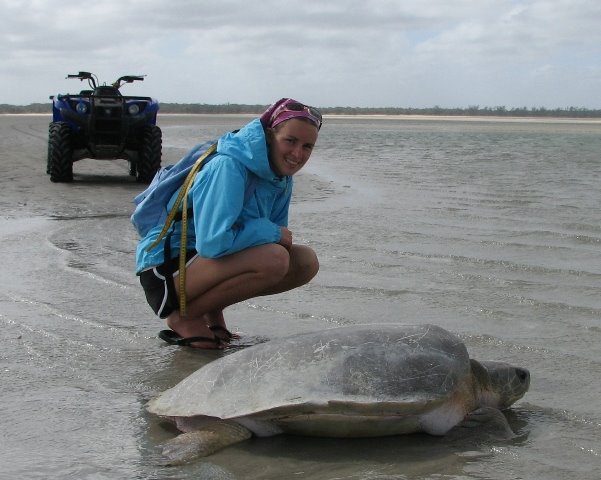Friday, February 5, 2010
Brett & Kelsey's adventure to a remote, hostile island in Northern Australia
Thursday, February 4, 2010
Wednesday, February 3, 2010
Tuesday, February 2, 2010
Monday, February 1, 2010
Friday, June 19, 2009
Tuesday, May 26, 2009
An early season visit...
I was lucky enough to be back on Crab Island for a few days at the end of April. This is one of the earliest times of the year that anyone has assessed nesting on the island. I was lucky to have 3 traditional owners from Injinoo accompany along with my work colleague Ben Jones.
It poured down rain, but it was a great trip. I had picked some promising tides around the new moon and was curious to see what level, if any, nesting was occurring. To my surprise we counted close to 50 turtles on the first night we were there! The next night only 5. It goes to show that the island can still produce some good nesting outside the main nesting season.
Wednesday, December 10, 2008
Reflecting on 2008 - what a year!
It is nearly 2009 already! As I sit here in Toronto, Canada, and watch the snow fall outside it is hard to believe we were on Crab Island only a few weeks ago. It has been an amazing year full of new discoveries and amazing experiences after several trips to the island. I would have to write a book to list them all, but here are some:
o Witnessing and documenting, for the first time, crocodile predation on sea turtle hatchlings, and the previously unknown congregation of crocs on the island;
o Having the privilege to witness thousands of flatback turtles nest and hatchlings emerge;
o Having the unique experience of sharing an island with dozens of crocodiles, seeing their behaviours night after night;
o The times when we were literally surrounded by nesting turtles and hatchlings;
o Coming face-to-face with ‘Godzilla’, a massive 6m+ (18ft+) crocodile I had heard many stories about dating back to the 70’s and finally got to see him one night on the beach on Crab Island (with an adult sea turtle in his mouth);
o Successfully deploying satellite trackers and determining migration paths and feeding grounds of Crab island flatbacks for the first time;
o Tracking flatback turtles outside of Australia for the first time and identifying feeding grounds in Indonesia;
o Being able to collect remigration and renesting intervals for the first time;
o Being able to work with and enjoy the company of the Torres Strait Islander and Aboriginal people of the area;
o Discovering significant Olive Ridley nesting in the area;
o Adding many new species to the Crab Island list, including many rare birds, frogs and several snakes;
o Seeing the seasonal changes on the island and the cycle of the wildlife, including migratory birds, tiger sharks, indo pacific humpback dolphins, and of course the sea turtles and crocodiles;
o Being able to spend quality time on Crab Island, getting to know and understand the natural rhythms and discovering it’s unique ecology;
Most importantly, the data we have collected is a step forward for effective conservation of the world's largest nesting population of flatback turtles.
Crab Island is certainly a wild and fascinating place… I can’t wait until we are back on beaches again next year!! In the meantime I am eagerly watching the migration patterns of our satellite tracked girls...
Monday, November 17, 2008
Nat crosses the Australian/ Indonesian border
Nat made history on Monday the 17th November. She is the first Flatback Sea Turtle to be ever tracked outside of Australia. She crossed the Australian border and is now in Indonesian waters heading towards Irian Jaya in Western Papua.
Nat will provide some of the first evidence of where flatbacks feed outside of Australia.
To see where Nat is right now click here
Saturday, November 15, 2008
A scene from the Jurassic age
Friday, November 14, 2008
Tuesday, November 11, 2008
Follow the turtles on the web
Alby Out (by Scott, aka Alby)
Off the Island (by Kelsey)
*Crab Island from the air
In Seisia we cleaned the long boat, quads, and gear. We packed away the things that will stay up on Cape York, thanks to Greg giving us the space to do so. After getting all of that sorted and doing laundry, we enjoyed showers, time to relax, and fresh food.
The next day we took the morning ferry to Thursday Island where we spent about 5 hours before our flight. We hung out in a friendly café located in the cultural centre. Here we used the internet, uploaded photos, relaxed in the shade, and had some good food. Then we were off by ferry to Horn Island, where the local airport is. The flight from Horn Island to Cairns has beautiful views. We first watched Crab Island go by under us…it looks so big from up in the sky. Then we flew over other islands which make up the Great Barrier Reef...how spectacular! Once we landed in Cairns and settled in we took Scott down to the Esplanade to see a little of Cairns. We walked along the boardwalk to the Pier for dinner…it was nice to be waited on. Being back in civilization can be overwhelming at first; but it is amazing how much you appreciate all the little things so much more after living on a remote island for a long time.
It was back to reality today after we said goodbye to Scott. We had such a fantastic trip, which made it so sad to have it come to an end. It sure was great having Scott on the island with Brett and me. He was certainly in his element and he took on the wilds like a man who had never seen civilisation! Being able to share what we love was a good feeling. Tomorrow Brett and I head south and I hope we will soon be planning another trip in the near future back up to Crab, our island home!
Monday, November 10, 2008
Leaving the Island
It is always an anxious time when it comes to leaving the island – hopefully the wind and tides are ok, and the boat starts and runs well. It is also the time when you are spending a lot of time in and around the water, so hopefully the crocs aren’t hungry also! It is definitely not a time to be complacent. The island is remote and it is a long trip back to ‘civilisation’.
We timed the tide to allow the boat to be sitting high and dry on the beach in the morning so we could load it safely with gear and the quads. Thankfully we woke up to a beautiful day and loaded up the boat before waiting for the tide to wash underneath and float the boat. Once this happened around 9am we were off. We cruised along nicely and spent some time surveying the mainland beaches for turtle nesting and spotting wildlife, such as Jabirus. At one stage we stopped to have a cast at some tuna schools which were hitting bait fish at the surface – unfortunately they were submerging quickly and proved tough to keep up with, so we moved on with our dreams of fresh sashimi passing by..
After a good, smooth run Scott pulled the boat up in Seisia mid-morning. The weather Gods had smiled. Seisia is now a very sleepy little outpost now the tourist season is over and no 4wds are heading up Cape York due to the beginning of the wet season.
Tiger Sharks

* an image of a tiger shark attacking a green turtle at Raine Island on the Northern Great Barrier Reef (a few hundred kilometres to the east of Crab island). Raine Island is the only place in the world where tiger sharks are known to congregate. They time this to feed on the nesting sea turtles.
Fishing Frenzy (by Kelsey)
Saturday, November 8, 2008
Swimming with Crocodiles
The seasons are changing here in the far north of Australia, with a shift from the predominant south east trade winds which blow consistently for 8 months of the year to the more gentle northerlies. With this brings clearer water around Crab Island. It also provided a unique opportunity to take a dip with a curious reptilian friend and get a little bit of underwater footage. He was keen to check me out and I was wrapped to spend some time swimming with the friendly fella. I will post some video at a later date...
Poor Pelican
Brett and I went out to do a routine check for turtles nesting last night. As we headed around the northern part of Crab Island we noticed a croc up on the beach. It seemed hesitant to leave but as we drove closer on the quad it ran back to the water. When we got up to his tracks we looked up the beach to find a dead pelican on the ground. (For a side note the Australian Pelican is much larger than its relative seen in America. This massive bird has a wingspan of 2.3-2.5 metres). Of course we had to have a closer look. We found that the 3.5 metre croc went up the beach about 55 metres to the point where the attack occurred. What a commotion it must have been, there were scuffle marks in the sand, blood, and feathers. So when we saw the croc he was dragging the pelican down the beach but dropped it in order to get to the water before we arrived. He dragged the pelican about 30 metres before he reluctantly dropped it. We saw bite marks on the pelicans back and neck. Either the croc snuck up and attacked the pelican or a group of pelicans landed near the croc and startled him which caused the attack. Whichever way the attack occurred the poor pelican was in the wrong place at the wrong time. This morning we saw the pelican still on the beach in the same spot, so we must have startled the croc enough for him to drop the pelican and not return. You never know what you are going to find on Crab Island that’s for sure.
Gigantic Starfish
Nora the nomad...
Our final transmitter was attached with much relief. Due to the tides (a falling tide all night), the turtles have been reluctant to nest and we have had a couple quiet nights. With time running out we were starting to wonder if we would get the last transmitters on. Luckily we had a couple of girls come up to nest near camp and we maneged to deploy the last 2 transmitters. The final transmitter was on Nora the Nomad, otherwise known as ‘Bloody Nora’ for her feisty character. Nora was keen to bite anything that came near her and proved a handful. She was also quite a picky girl having wandered over 100m along the beach and dug several body pits. We got her as she was returning to the water without actually laying, so we expect her to nest again in the next few nights.
Kel-Sea is on her way!!
We attached our 4th satellite transmitter to a girl we named Kel-Sea. She was quite a large turtle, by far the biggest we have put a satellite tag on. It took a fare bit of effort to hold her up and attach the harness, but in the end we did it quickly and had her on her way within 30 minutes. As of yesterday afternoon she was sitting just 3 kilometres off Crab Island’s south west corner.
Friday, November 7, 2008
The migration begins..
If you had read the last post you would have noted that i mentioned that Nat may migrate sooner than later because she is close to the end of her nesting. Well it seems she may be on her way. After a couple of days she is moving rapidly to the north west of Crab and is now over 100kms away. Will be interesting to see where her home lies....
Nat and Wombat with sat transmitters attached
*Wombat and Wombat
We have now deployed another 2 satellite transmitters on 2 turtles we have named Wombat and Nat (Nat is short for the flatbacks scientific name, Natator depressus). The nesting on the island has shifted to the north so we had to put all the gear on the ATVs and travel up that way to find some eligible candidates. Wombat was a nice clean turtle which provides less of a chance of the transmitter fouling up from barnacles, etc. Nat was a turtle we had met back in early September. We had tagged her in about the second week of our last trip. This means that she is most likely towards the end of her breeding for this season and we may see her migrate back to her feeding grounds soon. Having a history of Nat will provide us with valuable data.
*Nat with transmitter attached:
.jpg)
.jpg)
.jpg)
.jpg)























